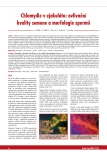Chlamydias in ejaculate; the influence on the quality and morphology of sperms
Authors:
prof. MVDr. Zdeněk Věžník, DrSc. 1; prof. MUDr. Leopold Pospíšil, DrSc. 1; Ing. Drahomíra Švecová 1; MVDr. Atanaska Zajícová 1; doc. MUDr. Vít Unzeitig, CSc. 2
Authors‘ workplace:
Výzkumný ústav veterinárního lékařství, Brno
1; Gynekologicko-porodnická klinika LF MU a FN Brno
2
Published in:
Prakt Gyn 2005; 9(2): 6-9
Overview
Chlamydias in ejaculate; the influence on the quality and morphology of sperms. In the rich literature about genital chlamydiosis there is relatively few publications dedicated to the presence of chlamydias in ejaculates. Therefore the authors present the analysis of their own spermatologic monitoring in the set of 991 male ejaculates. For direct proof of chlamydias there had been used an immunofluorescent reaction using the Progen Biotechnik GmbH set. The results of spermatoanalyses arose from a short-term survivability test (120 min) with a determination of sperms motility, the speed of sperm mobility and determination of percentage of living sperms. To evaluate the morphologic examination of ejaculates there had been used a computer program „strict morphologic analysis of ejaculate – SASMO“. The presence of chlamydias was confirmed in 199 ejaculates (20,08 %). At the spermatologic examination of ejaculates with positive and negative finding of chlamydias the differences in relative values of individual criteria were detected. The ejaculates contamined with chlamydias showed the volume lower by 7%, the concentration lower by 8,3%, motility lower by 7,8%, speed of sperms mobility lower by 9,6%, the share of normally created sperms lower by 14,4%. The differences of the averages of normosperms of two compared groups were statistically highly significant (p = 0,01), at the sperm motility they were significant (p = 0,05).
Key words:
chlamydias – direct proof – male semen –spermatoanalysis
Sources
1.Bowle WR, Caldwell HD, Jones R P et al (eds). Chlamydial Infections. Proceedings of the Seventh Int. Symp. on Human Chlamydial Infections. Cambridge: Cambridge University Press 1990: 602.
2.Orfila J, Byrne GI, Chernesky MA et al (eds). Chlamydial Infections. Proceedings of the Eighth Int. Symp. on Human Chlamydial Infections. Gouvieux-Chantilly, France, June 19.–24. Bologna: Editrice Esculapio 1994: 640.
3.Stary A (ed.). Proceedings of the third Meeting of the European Society for Chlamydia Research. Vienna, Sept. 11.–14. 1996.
4.Saikku P. Proceedings Fourth meeting of the European Society for Chlamydia Research. August 20.–23. 2000, Helsinki, Finland.
5.Schachter J, Christiansen G, Clarke IN et al (eds). Chlamydial infections. Proceedings of Tenth international Symposium on Human Chlamydial Infections. June 16.–21. 2002, Antalya, Turkey.
6.Eggert-Kruse WS, Clussmann C, Zwick EM. Complications of the Chlamydia trachomatis infection in males, Proceeding Fourth meeting of the European Society for Chlamydia Research. August 20.–23. 2000, Helsinki, Finland.
7.Řezáčová J, Mašata J, Přibylová M. Chlamydia trachomatis and its effect on male fertility. In: Chlamydial infections, Proceedings of Tenth international Symposium on Human Chlamydial Infections. June 16.–21. 2002, Antalya, Turkey.
8.Bollmann R, Engel S, Petzold R. Chlamydia trachomatis in andrologic patients – direct and indirect detection. Infection 2001; 29: 113-118.
9.Videau P, Vivas C, Salazar N. IgA Antibodies to Chlamydia trachomatis and seminal parameters in asymptomatic infertile males. Arch Androl 2001; 46: 189-195.
10.Gdoura R, Daoudi F, Bouzid F et al. Detection of Chlamydia trachomatis in semen and urethral specimen from male members of infertile couples in Tunisia. Eur J Contracept Repris Health Care 2001; 6: 14-20.
11.Věžník Z, Švecová D, Pospíšil L, Diblíková I. Direct demonstration by immunofluorescence of chlamydiae in animal and human semen. Vet Med–Czech 1996; 41: 201-206.
12.Věžník Z, Pospíšil L, Švecová D, Zajícová A. Chlamydie v ejakulátech. Remedia Klin Mikrobiol 1998; 2: 79-82.
13.Vigil P, Morales P, Tapia A. Chlamydia trachomatis infection in male partners of infertile couples – incidence and sperm function. Andrologia 2002; 34: 155-161.
14.Hosseinzadeh S, Brewis IA, Eley A, Pacey AA. Co-incubation of human spermatozoa with Chlamydia trachomatis serovar E causes premature sperm death. Hum Reprod 2001; 16: 293-299.
15.Pospíšil L, Diblíková I, Věžník Z, Zralý Z, Horová J, Budíková M. Production of anti sperm antibodies associated with Chlamydia infected in rabbis. Vet Med-Czech 2000; 45: 163-170.
16.Westenberg SM, Defoer JM, Pannekoek Y. A Comparison between four antichlamydial antibody assays during course of genital infection with chlamydia trachomatis in a semen donor. In: Chlamydial infections. Proceedings of Tenth international Symposium on Human Chlamydial Infections. June 16.–21.2002, Antalya, Turkey: 448.
17.Pospíšil L, Dragon J, Věžník Z, Diblíková I. Direct and indirect demonstration of Chlamydia spp. in patients suffering from non‑specific uretritis. Čs Dermat 1996; 31: 166-170.
18.Weidner W, Diemer T, Hawe P. The role of Chlamydia trachomatis in prostatitis. Int J of antimicrobiol Agents 2002; 19: 466-470.
19.Keck C, Gerber-Schafer C, Clad A et al. Seminal tract infections: impact on male fertility and treatment options. Human Reprod Update 1998; 4: 891-903.
20.Chernesky MA, Lee H, Schachter J. Diagnosis of Chlamydia trachomatis infection in symptomatic and asymptomatic men by the first void urine in Ligase-Chain-Reaction-Assay. J Infect Dis 1994; 170: 1308-1311.
21.Hartung RG. Nachweis von Chlamydia trachomatis im menschlichen Ejakulat mit Hilfe des Pathfinder Chlamydia EIA Detection Kits. Diss Düsseldorf Mainz 1993: 73.
22.Petersen EE, Clad A. Detection of asymptomatic chlamydial infections in women and men by screeningu of first-void urine with Ligase Chin Reaction (LCR). Proceedings of the 7th Intern. Congress for Infections Diseases, Hongkong 1996; 47-48.
23.Věžník Z, Švecová D, Pospíšil L, Zajícová A. Změny kvality ejakulátů ve vztahu k infekci pohlavních orgánů chlamydiemi. 2. ročník Mezinárodní konference Chlamydiové infekce, Brno 13.–15.11. 2003.
24.Pospíšil L, Pilka L, Věžník Z. To the problem of chlamydial infections (a methodological proposal). Gynekolog 1998; 7: 211-212.
25. Věžník Z, Pospíšil L, Švecová D et al. Stanovení optimálních postupů při tlumení chlamydióz jako příčiny poruch plodnosti zvířat a lidí. Brno: ZZ VÚVeL 1997: 30.
Labels
Paediatric gynaecology Gynaecology and obstetrics Reproduction medicineArticle was published in
Practical Gynecology

2005 Issue 2
Most read in this issue
- Chlamydias in ejaculate; the influence on the quality and morphology of sperms
- Developmental defects in reproduction losses in the 1st trimester of pregnancy
- Minimal stimulation in the IVF/ICSI+ET programme
- Controversions in perimenopause and postmenopause
